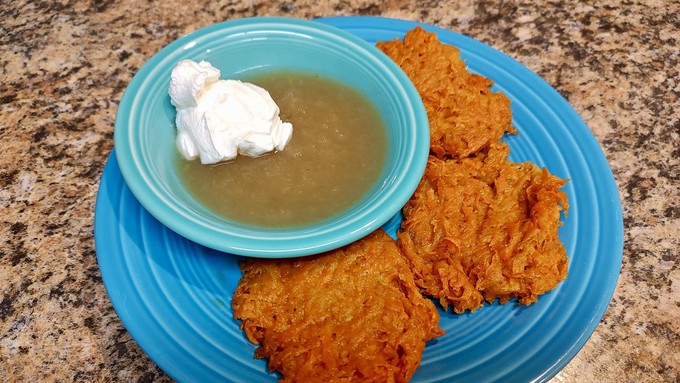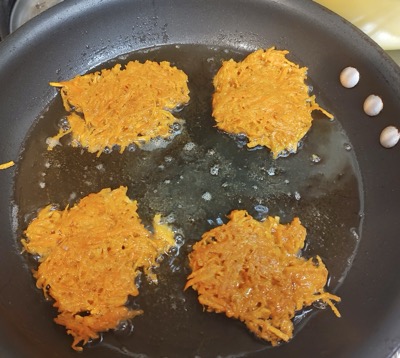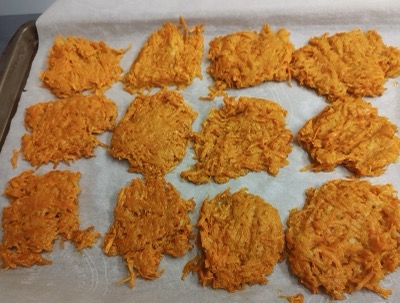
Recipe: Sweet potato latkes, served with applesauce and sour cream

Pair sweet potato latkes with the traditional applesauce and sour cream. Debbie Arrington
Happy Hanukkah! My favorite food of this holiday season: Latkes.
Fried in oil, latkes are an edible nod to Hanukkah’s origin story. In Jerusalem’s Holy Temple, lamp oil that was not supposed to last more than one night miraculously stretched to eight nights.

The purest olive oil was used for the temple’s lamp. For my sweet potato latkes, I prefer vegetable oil. This twist on traditional potato latkes uses bright orange sweet potatoes for more color (and antioxidants – these fried potatoes are good for you). I serve them with my homegrown applesauce and sour cream.
Sweet potato latkes also make a savory appetizer. Instead of applesauce, top with sour cream or crème fraiche and a little caviar.
Sweet potato latkes
Makes about 12
Ingredients:
1 pound sweet potatoes, peeled
½ yellow onion
¼ cup flour
½ teaspoon baking powder
½ teaspoon salt
¼ teaspoon pepper
2 eggs
Vegetable oil for frying
Applesauce (optional)
Sour cream (optional)
Instructions:
Preheat oven to 200 degrees F. Line a cookie sheet with paper towels or parchment paper. Set aside.
Grate sweet potatoes, either by hand or with a food processor. Soak grated sweet potatoes in a large bowl of salted water (about 1/2 teaspoon salt to 1 quart water) while assembling the other ingredients.
Grate onion. Wrap in a paper towel and press much as water as possible out of the grated onion. Put grated onion in a large bowl.
Drain grated sweet potatoes in a sieve, pressing out the water. Add sweet potatoes to onion in the bowl; toss to combine.
In a small bowl or cup, mix together flour, baking powder, salt and pepper. Add to sweet potato mixture.
Lightly beat eggs and add to the sweet potato mixture.
In a large skillet, heat vegetable oil over medium-high heat. It should cover the bottom of the pan about ¼ inch deep.
Using two wooden spoons, scoop about ¼ cup of sweet potato mixture and drop into hot oil. With the back of the spoon, gently flatten the scoops into patties. Repeat as room allows in the pan without overcrowding.

Fry each patty until golden brown on each side and crispy on the edges, turning once; about 5 to 7 minutes total per patty. As the latkes finish cooking, remove them from the pan and set on the prepared baking sheet. Keep the latkes warm in the oven until all of them are fried.
Serve immediately with applesauce and sour cream, if desired.
Comments
0 comments have been posted.Sacramento Digs Gardening to your inbox.
Sites We Like
Garden Checklist for week of July 21
Your garden needs you!
* Keep your vegetable garden watered, mulched and weeded. Water before 8 a.m. to reduce the chance of fungal infection and to conserve moisture.
* Feed vegetable plants bone meal, rock phosphate or other fertilizers high in phosphate to stimulate more blooms and fruiting. (But wait until daily high temperatures drop out of the 100s.)
* Don’t let tomatoes wilt or dry out completely. Give tomatoes a deep watering two to three times a week.
* Harvest vegetables promptly to encourage plants to produce more. Squash especially tends to grow rapidly in hot weather. Keep an eye on zucchini.
* Pinch back chrysanthemums for bushy plants and more flowers in September.
* Remove spent flowers from roses, daylilies and other bloomers as they finish flowering.
* Pinch off blooms from basil so the plant will grow more leaves.
* Cut back lavender after flowering to promote a second bloom.
* It's not too late to add a splash of color. Plant petunias, snapdragons, zinnias and marigolds.
* From seed, plant corn, pumpkins, radishes, winter squash and sunflowers.